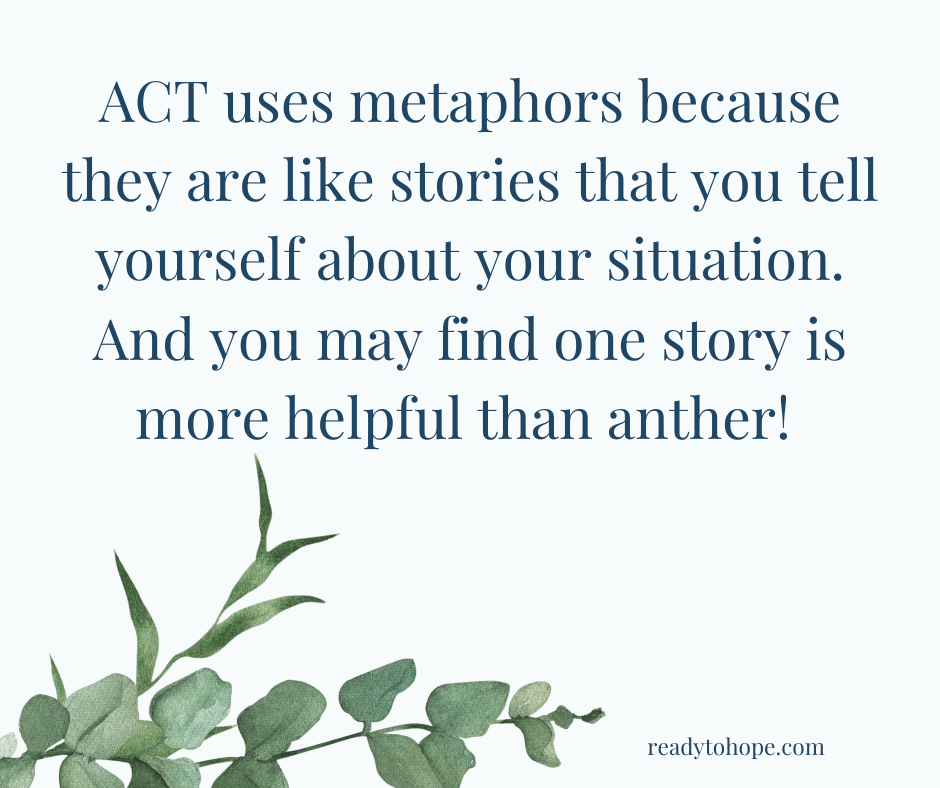Introduction to ACT Therapy “Tools”

So far we’ve discussed a broad overview of Acceptance and Commitment Therapy (ACT, pronounced “act” because it is an action-oriented therapy!), and we’ve looked at the core processes involved in ACT.
This week we’ll dive into a few “tools” that you can apply to your own life!
First, why do I keep saying “tools” in parentheses? (Which by the way, I’ll stop now.)
If you have read the other posts you know: ACT is different from a lot of traditional therapies.
The first part of ACT is acceptance.
In so many types of therapy, the goal has been to somehow make the negative thoughts stop, or at least minimize them.
ACT instead begins with accepting your thoughts, even the ones that challenge you.
We know that running away from feelings doesn’t work, because they’re always with you. Instead, the wiser and kinder move is to accept that they are there with you, and then figure out what next steps you can take.
It makes sense, right?
But as we’ve talked about already in other posts: even if it’s logical to you, it can certainly be challenging to implement this shift!
First- it’s a habit you’ve been using for a long time. Through no fault of your own (as we will discuss next) you have grown to feel stress or anxiety or anger or fear, or whatever difficult emotions pop up for you in your day to day life, right?
So yes, it will be challenging to shift towards acceptance.
But hard does not mean impossible- and when you start to feel what acceptance looks like in action, you’ll soon understand how it can change the game for your mental wellness.

First: let’s talk about why it’s not your fault!
The Caveman Mind
In ACT it’s helpful to learn about The Caveman Mind. (Or Cavewoman, or Caveperson, whichever you prefer, but we’ll use Caveman for this discussion.)
The Caveman Mind refers to the fact that in the beginning of civilization, there were certain instincts and behaviors and thought processes that were essential- and no longer are essential.
The Caveman Mind was necessary to survive:
So. Many many generations ago, if you weren’t always on the lookout, if you weren’t always ready to fight or flee, you might not survive!
You had to be constantly vigilant, watching for threats.
And while we no longer face physical threats every day, we have evolved to be vigilant.
That vigilance? In our daily lives, that vigilance looks like stress and anxiety! It looks like instincts that cause you to melt down or run away when things get tough.
The Caveman Mind was necessary to fit in:
Once upon a time, it was absolutely necessary that the group would include you. You had to be a part of a group because if you were alone, it would be that much easier for you to become prey.
And while we no longer face that physical threat that makes being included necessary, the instinct hasn’t disappeared.
We feel the same desire to fit in, but fitting in can be hard! We not only live more separately and less communally, making it harder to make connections, but we carry devices in our pockets that ramp up our fear of not fitting in, constantly reminding us of how we are different, how others may have more or do more or be spending time with people more than we are, or that we wish we were spending time with.
We have an instinctive, evolutionary desire to fit in, but fitting in is hard!
The Caveman Mind was necessary to have the supplies you needed:
Once upon a time, it was essential for survival that you would hunt and gather and store up your food for winter. It was essential that you had proper shelter and collected the necessary supplies to have clothing and a roof over your head when bad weather hit.
Today, most of us never struggle for food or shelter, but the primitive impulse remains: we need to collect more stuff. We need the latest phone, the best shoes, the nicest car.
Are you seeing how it’s not your fault that you struggle with the feelings you struggle with!?
It is not your fault.
I’m going to say that again in case you are skimming and didn’t actually read that.
It is not your fault.

It is not your fault that you feel stress, anxiety, overwhelm, depression, anger, frustration, or fill in the blank.
Your brain is wired to keep you safe.
So your job: thank your brain, accept what it brings to you, and then learn the tools to mindfully move through whatever comes up.
Yes, I said thank your brain. And yes, it’s an ACT concept to thank your brain.
Why? Because your brain is only doing what it’s supposed to do. It may be hard to put up with what your brain throws at you sometimes, but it is not because your brain is flawed, or broken. You are not flawed, or broken.
So, say “Thanks brain for making me feel X, I know you’re only doing your job. Now I am going to do what I need to do to accept and move forward.”
ACT Metaphors
Part of the reason I put “tools” in parentheses is because while you’ll soon see that there are some great steps that you can implement to apply ACT metaphors, so much of the application part of ACT- the tools- are really about seeing your experience in a new light.
ACT uses metaphors because they are sort of like stories that you tell yourself about your situation, and because you are uniquely made, you may find one story that resonates with you more than another story (metaphor).
So with that said, let’s look at some ACT metaphors (tools)!
Dropping Anchor
Dropping Anchor is a metaphor you can apply when you feel overwhelmed by your emotions and aren’t sure how to get back on track. It might apply to feeling stressed out thinking about a test that’s coming up and how worried you are about it, or about something you said or did that you regret because you’re embarrassed or you wish you could take it back. It might just be simple overwhelm over everything at once!
How to Drop Anchor: ACE
A: Acknowledge your inner experience. The first step to accepting thoughts, feelings, emotions, memories, or sensations is to simply recognize them. You can say to yourself, “I am feeling stress,” or “I am feeling overwhelmed by that memory.” Or even: ‘There’s stress.” “There’s overwhelm.”
C: Come back into your body. You can regain a sense of control over your situation by focusing on what you can indeed control, which is how you are physically moving in space and time. So- place your feet on the ground and feel them there. Straighten your spine. Take a deep breath. You can even stand up and move around. The point is- feel yourself being in your body and in this space and time.
E: Engage with the world. Notice what is around you. What can you see, taste, smell, hear, and feel? Once you are grounded in your body, become grounded right where you are, in this space and time.
That’s it. There is certainly a mindfulness component, right?
You have these actions you can take, and you have a metaphor for your experience.
Think about a storm. When you are driving in a car and a storm comes up and it’s so intense you can’t drive safely, what do you do? You park your car, and you ride out the storm.
Your goal with Dropping Anchor is to learn how to come back to yourself and ground yourself when an emotional storm comes up. You can’t make the storm go away, but you can teach yourself to ride the waves that come along with it.
And a tip: this isn’t a one-and-done practice. You may need to keep going back through ACE until you feel more centered and grounded, and capable of taking effective action that aligns with your values. And that’s okay! The more you practice it, the quicker you will be able to feel grounded again.

Leaves on a Stream
Leaves on a Stream is another metaphor that you can call upon when your emotions feel like they are keeping you from being productive and acting according to your values.
How to practice Leaves on a Stream:
Find a Comfortable Position: Start by finding a comfortable seated position. You can sit on a chair or cushion, whichever feels most comfortable for you.
Close Your Eyes (Optional): While you can do this exercise with your eyes open, many people find it helpful to close their eyes to minimize distractions and enhance focus.
Visualize a Stream: Imagine yourself sitting beside a peaceful stream. Picture the water flowing gently downstream.
Place Your Thoughts on Leaves: As thoughts arise in your mind, imagine placing each one on a leaf and letting it float downstream. These thoughts can be anything – worries, memories, plans, or judgments.
Observe Without Judgment: As each thought floats away on its leaf, simply observe it without judgment. Notice its presence without getting caught up in its content. Allow each thought to come and go naturally.
Return to the Stream: If you find yourself getting carried away by a thought or becoming distracted, gently bring your focus back to the image of the stream and the leaves floating by.
Practice Letting Go: Remind yourself that thoughts are like leaves on a stream – they come and go, but you don’t have to follow each one. Practice letting go of the urge to engage with or analyze your thoughts.
Additional Metaphors
Below are a handful of additional metaphors. With ACT, it is about finding what resonates with you. The goal would be that the next time you feel stressed or anxious or sad or overwhelmed, (or any of those feelings that inevitably will come because you are a human being having a human experience) that you might find a metaphor that speaks to you and can help you feel more grounded and centered.
The Bus Driver:
With this metaphor, you can think of yourself as a bus driver, navigating your life. The passengers on this bus are all your thoughts and emotions. If you’ve ridden a school bus, you know that some of those passengers can get unruly, right? So with this metaphor, you think about how as the bus driver, you don’t try to kick off unwanted passengers (or in other words, suppress difficult thoughts or feelings), but instead you learn to allow all the passengers while choosing which to act upon, in a mindful, values-based manner.
The Tug-of-War:
Ever played tug-of-war? If you’re up against a good opponent, you know that the more you pull, the more resistance you are going to get back! So you can think of the rope as representing the fight against the feelings that come up for you. Instead of pulling and getting more uncomfortable and having to work harder, you drop the rope. Dropping the rope is the same as acceptance, and it can help you reduce the struggle and move forward towards your goals in an action-oriented way.
The Chinese Finger Trap:
This metaphor is just like the tug-of-war, really, so it’s a matter of which seems to speak to you more. With this, you can compare getting stuck in unhelpful thoughts and feelings to the experience of having your fingers in a Chinese finger trap. The harder you pull, the more stuck you become. When you relax and move with the trap (acceptance), suddenly your fingers can become free, and you can carry on with your day.
The Beach Ball:
Imagine trying to hold a beach ball underwater – the harder you push it down, the more it resists and pops back up! You can think of your emotions like the beach ball- the more you try to push them down, ignore them, push them aside, or even try to distract yourself from them, they often instead become more intense. So this metaphor says- what if you just let the ball pop up and do its thing? By letting go and allowing the beach ball (challenging feelings) to float naturally (acceptance), you can feel more present and capable of moving forward.
The Unwelcome Guest:
As an introvert this one really speaks to me! This metaphor compares unwanted thoughts or emotions to an unwelcome guest at a party. Imagine that person that is loud or demands all the attention or is rude. You could try to get them to leave. You could sit and stew over how annoying they are and how frustrated you are. You could take the bait and engage with them. Instead, this metaphor suggests that you simply acknowledge their presence, don’t give them any extra attention, and allow them to leave in their own time.

Are you able to see why I was putting “tools” in quotes?
When it comes to ACT therapy, the acceptance comes from making peace with the fact that you are going to face challenges and difficult emotions, and these metaphors and activities offer you a number of ways to look at those challenges and emotions in a different light.
You aren’t running away from hard thoughts and feelings, but instead you are seeking a little space!
Once you can ground yourself and begin to have a little breathing room between the difficult inner experiences, you then will find yourself in a better space to choose your next step!
And that is the committed action part of ACT- choosing to move forward, despite the truth that life will continue to challenge you, with purpose and according to your values.
Hopefully something here has clicked for you and you’ve found yourself saying, “I can see myself using that metaphor…”
As we’ve discussed- this takes time and practice. So be kind and gentle with yourself because you are not at fault for having challenging thoughts and feelings. Your goal as you implement ACT is to remember that you’re a human being having a human experience, and with that will come all sorts of challenges.
So it’s not a matter of if you’ll feel challenging feelings- it is a matter of what you can choose to do when they pop up!
And as always, we would love to connect with you and answer any questions you may have- or just be an ear if you need one. Never hesitate to reach out!
And as always, you can go even deeper with these tools and gain more tools, along with meaningful connections, in one of our workshops or at a Ready to Hope Club activity!
You can stay up to speed on all we have going on by following us on Instagram or joining our email list- those links are below!
Until next time, take good care of you and remember: there is always a way through.



